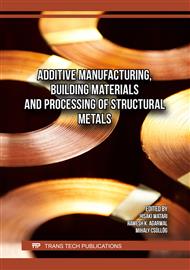[1]
X. Shi, N. Xie and J. Gong. Durability of steel reinforced concrete in chloride environments: an overview. Construction and Building Materials, v. 30, pp.125-138, 2012.
DOI: 10.1016/j.conbuildmat.2011.12.038
Google Scholar
[2]
N.Z. Muhammad, A. Keyvanfar, M.Z.A. Majid, A. Shafaghat and J. Mirza. Waterproof performance of concrete: a critical review on implemented approaches. Construction and Building Materials, v. 101 (1), pp.80-90, 2015.
DOI: 10.1016/j.conbuildmat.2015.10.048
Google Scholar
[3]
D. López, N. Acelas and F. Mondragón. Average structural analysis of tar obtained from pyrolysis of wood. Bioresource Technology, v. 101, pp.2458-2465, 2010.
DOI: 10.1016/j.biortech.2009.11.036
Google Scholar
[4]
S. Jahandari, Z. Tao, M.A. Alim and W. Li. Integral waterproof concrete: a comprehensive review. Journal of Building Engineering, v. 78, 107718, 2023.
DOI: 10.1016/j.jobe.2023.107718
Google Scholar
[5]
B.S. Yang, J. Yang, D. Kim, J. Kim, W. Hwang and G. Kwon. Characteristics of wood tar produced as byproduct from two types of the kiln in the manufacture of oak charcoal. Journal of the Korean Wood Science and Technology, v. 45 (6), pp.772-786, 2017.
DOI: 10.5658/wood.2017.45.6.772
Google Scholar
[6]
B.J. Mahler, P.C. van Metre, J.L. Crane, A.W. Watts, M. Scoggins and E.S. Williams. Coal-tar-based pavement sealcoat and PAHs: implications for the environment, human health, and stormwater management. Environmental Science and Technology, v. 46, pp.3039-3045, 2012.
DOI: 10.1021/es203699x
Google Scholar
[7]
H. Pakdel and C. Roy. Chemical characterization of wood pyrolysis oils obtained in a vacuum-pyrolysis multiple-hearth reactor. In: American Chemical Society Symposium Series, v. 376, Chapter 19, pp.203-219, 1988.
DOI: 10.1021/bk-1988-0376.ch019
Google Scholar
[8]
Brazilian Association for Technical Standards. Mortar and hardened concrete (NBR 9779) – determination of water absorption by capillarity, 2012.
Google Scholar
[9]
M.L. Willson and P. Tennis. Design and control of concrete mixtures. Portland Cement Association, 17th Edition, 2021.
Google Scholar
[10]
A. Heidari, E. Khaki, H. Younesi, and H. R. Lu. Evaluation of fast and slow pyrolysis methods for bio-oil and activated carbon production from eucalyptus wastes using a life cycle assessment approach. Journal of Cleaner Production, v. 241, 118394, 2019.
DOI: 10.1016/j.jclepro.2019.118394
Google Scholar
[11]
W. B. Wilson, H. V. Hayes, L. C. Sander, A. D. Campiglia, and S. A. Wise. Qualitative characterization of SRM 1597a coal tar for polycyclic aromatic hydrocarbons and methyl-substituted derivatives via normal-phase liquid chromatography and gas chromatography/mass spectrometry. Analytical and Bioanalytical Chemistry, v. 409, p.5171–5183, 2017.
DOI: 10.1007/s00216-017-0464-x
Google Scholar
[12]
X.-H. Guo, X-Y. Wei, L. Hu, X-J. Liu, M.-X. Chen, M.-L. Xu, and Z.-M. Zong. Molecular characterization of a middle/low-temperature coal tar by multiple mass spectrometries. Fuel, v. 306, 121435, 2021.
DOI: 10.1016/j.fuel.2021.121435
Google Scholar


